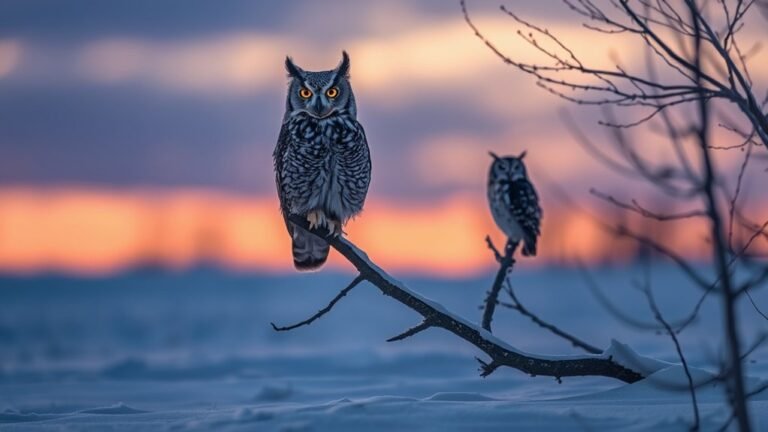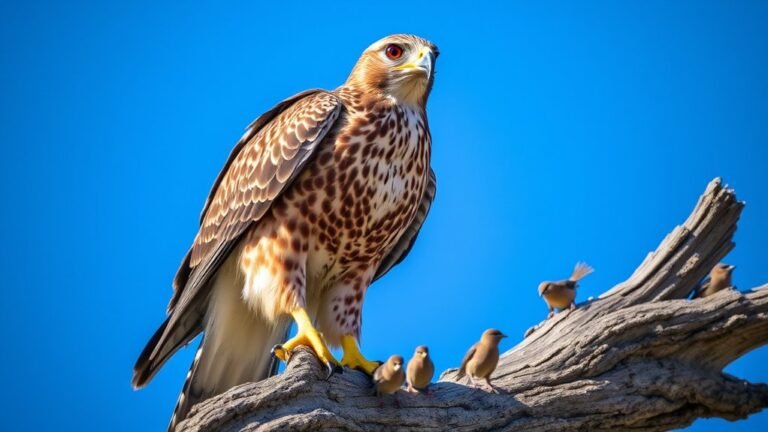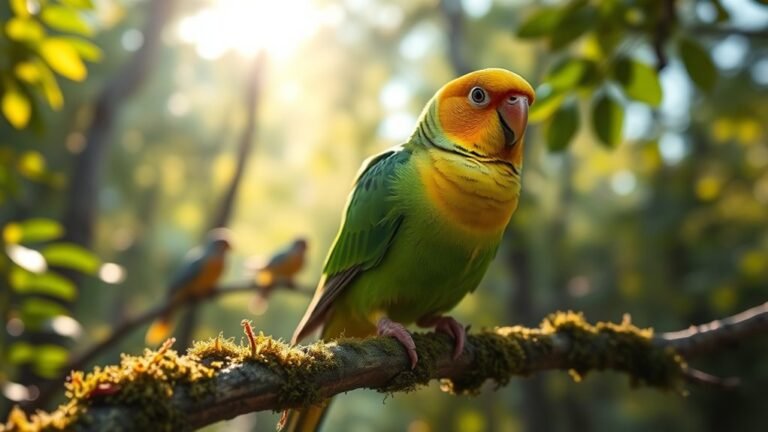Brown and White Birds: Recognizing Common Species
When you see brown and white birds, look for their special features and behaviors. Each bird likes a specific place to live. For example, the American Tree Sparrow has rust-colored wings and stays in grasslands. House Sparrows, which are social, live in cities.
As you spot these birds, listen to their calls and watch how they find food. There is a lot of variety in brown and white birds, and they all have something unique to offer. Learning about their differences can help you identify them better and enjoy birdwatching more!
A Quick Overview
- The American Tree Sparrow has a brown cap on its head and rust-colored wings. You can find it in shrubby fields when it is migrating.
- The House Sparrow lives in cities and towns. Its brown feathers help it blend in. These birds are social and usually gather in flocks to look for food together.
- Song Sparrows are famous for their lovely songs. You can see them in marshes and yards. They often search for food on the ground or in low bushes.
- Eastern Towhees have feathers that help them hide well. They scratch the ground to find seeds and insects in open areas.
- Watching how these birds look and behave can help you identify them. It also shows how they adapt to survive in their environments.
Understanding Brown and White Birds

When you see brown and white birds, pay attention to their colors. These colors help them survive. Their feathers can help them hide in their homes, like fields, forests, and wetlands.
Each type of bird has its own feather patterns that tell us where they live and how they act. For example, some sparrows have stripes that help them blend into tall grass. This keeps them safe from predators. Other birds may have white patches that help them communicate with friends or mates.
The American Tree Sparrow
The American Tree Sparrow is a small and pretty bird. It's about 6 to 7 inches long and has a brown cap on its head and rust-colored wings. Its body is grayish-brown with a clean white underside. It has a special bill that's yellow at the base and dark at the tip.
You can find the American Tree Sparrow in places like shrubby fields and grasslands. It likes weedy areas and the edges of forests, especially during migration.
When you look for this bird, you might see it hopping around low shrubs or searching for seeds on the ground.
These unique features and the places it lives make the American Tree Sparrow a fun bird to spot. Enjoy watching it and taking in the beauty of nature!
The House Sparrow

House Sparrows are common birds found in cities and suburbs. They're small, with brown feathers that help them blend in. These birds are very good at living around people and can be seen in many places.
Watching them can help you appreciate how resilient they are.
- Nesting habits: House Sparrows like to make their homes in eaves, vents, or sheltered areas. They often nest together in groups.
- Foraging behaviors: They look for seeds, scraps, and insects to eat, showing how clever they're at finding food.
- Social interactions: You can often see them in flocks, chirping and chattering to each other.
Learning about House Sparrows and where they like to live can make your backyard birdwatching more fun. You'll feel more connected to nature as you watch these little birds go about their day.
The Song Sparrow
Song Sparrows are cheerful birds known for their lovely songs. They live in many places like marshes and yards. Their songs are rich and varied, often with a nice rhythm. You may hear trills and repeated phrases. These songs help them claim their territory and find mates.
When you watch Song Sparrows, you'll see them looking for food on the ground or sitting on low bushes. They like areas with thick plants where they can hide and find food like seeds and insects.
Learning about these birds helps you connect with nature and enjoy birdwatching even more. Their beautiful music adds to nature's amazing sounds.
The Dark-eyed Junco

The Dark-eyed Junco is a small bird that many people see in winter. It has a gray body and a white belly, making it easy to recognize. You'll often spot these birds in groups.
Where They Live: Juncos like to be in mixed woods, gardens, and open spaces, especially when it's cold outside.
What They Eat: These birds search on the ground for food. They mostly eat seeds from grasses and plants.
Sometimes, they also eat insects.
How They Act: When in groups, Juncos hop around energetically, especially while looking for food.
Watching them can be quite fun!
The Eastern Towhee
The Eastern Towhee is a beautiful bird that lives in bushes and along the edges of forests. It has a striking black back and bright rusty sides, making it easy to spot. This bird has a special way of finding food. It scratches the ground and flips over leaves to look for seeds and insects.
Eastern Towhees love places with thick plants that provide cover for nesting and safety. When you hike through their habitat, you might get a nice surprise seeing one hop around in the underbrush.
As the sun rises, you can listen for their cheerful call that sounds like "drink-your-tea." This lovely sound brings joy to the morning and makes your outdoor adventure even better.
Keep your eyes open for this charming bird and enjoy watching it in its home!
The Field Sparrow
The Field Sparrow is a cute bird that lives in open fields. It has a nice song and is fun to watch. You can find this bird in areas with bushes and grass.
Here are some things the Field Sparrow likes to do:
- Looking for food: It searches for seeds and bugs in the tall grass.
- Singing: It chirps sweet songs from high spots, especially during its mating season.
- Building nests: It makes nests on the ground using grass and twigs. Its nests blend in well with the surroundings.
The Field Sparrow is charming and has unique calls. Watching it can help you feel more connected to nature.
It's a simple pleasure to enjoy this little bird in the great outdoors!
The Chipping Sparrow
Chipping Sparrows are small birds that have pretty reddish-brown caps on their heads and soft, streaked feathers. You can often see them hopping around in your yard or in grassy areas. They like open spaces, low bushes, and scattered trees because they search for seeds and insects to eat.
These birds have a happy, cheerful song. You might hear them singing as they set up their homes and mark their territory. During mating season, male Chipping Sparrows show off their bright colors in fun displays to attract females.
When you put birdseed out, Chipping Sparrows will quickly hop around your feeder, showcasing their friendly nature.
If you take the time to watch them, you'll enjoy the lively life that fills your backyard.
The American Woodcock
The American Woodcock is a unique bird that can be hard to spot. It has a round body and a long beak. This bird likes to live in wet woods, areas with bushes, and open fields.
When you watch a woodcock, pay attention to these fun behaviors:
- Display Flights: Male woodcocks put on a show in the air. They fly in a fluttering pattern to attract females during mating season.
- Foraging Techniques: With their long beaks, woodcocks dig into the ground to find earthworms and insects. They're really good at finding food.
- Camouflage: The woodcock's brown feathers help it hide in the leaves. This makes it hard to see when it's still.
The Mourning Dove
The Mourning Dove is a bird that many people can easily spot. It has a slender body and a long, pointed tail, which helps it fly gracefully. This bird likes to live in places like parks and fields, making it common in cities and suburbs.
You can often see Mourning Doves sitting on power lines or picking up seeds from the ground, which is their favorite food. They're usually calm and make gentle cooing sounds, which add to their charm.
During courtship, male Mourning Doves show off their flying skills. They perform fun aerial displays, fluttering and gliding. This display is exciting for birdwatchers to see.
The Brown Thrasher
When you see a Brown Thrasher, you'll notice its bright rust-colored feathers and long tail. This bird has special traits that make it unique.
Usually, it lives in thick bushes, hedges, and gardens, so you might see it while taking a walk.
Here are some key features of the Brown Thrasher:
- Songs: This bird sings a wide range of tunes and can mimic other birds too.
- Searching for Food: It looks for food on the ground, digging for insects and berries.
- Size and Shape: It's medium-sized with a round body, long legs, and a noticeable long tail.
Knowing these details and where the Brown Thrasher likes to live can help you enjoy this interesting bird even more!
Tips for Spotting Brown and White Birds
Spotting brown and white birds can be a fun adventure! Here are some easy tips to help you find them.
Start your birdwatching in the early morning or late afternoon. This is when birds are most active! Look in different places like open fields, woods, and wetlands. These spots attract many types of birds.
Pay attention to little details. Look for how their wings look, listen to their songs, and watch how they move. Some birds like the White-throated Sparrow like to hide in thick bushes, while Northern Mockingbirds prefer open areas.
Stay quiet and be patient. If you make noise, the birds might fly away. By being calm, you can enjoy seeing these beautiful creatures up close.
Happy birdwatching!
Frequently Asked Questions
What Habitats Are Best for Spotting Brown and White Birds?
To find brown and white birds, check out forests. Forests have lots of trees and places for birds to hide. They are great spots for seeing different kinds of birds.
You can also look in cities. Parks and gardens in towns have trees and bushes. These areas can surprise you with bird sightings. Keep your eyes open for brown and white birds in both of these habitats!
How Can I Attract Brown and White Birds to My Yard?
To attract brown and white birds to your yard, place feeders near thick bushes. Make sure the feeders are easy for the birds to spot. Adding bird baths nearby will help create a nice place for them to drink and splash around.
Remember to refill the feeders and change the water often. Clean them too, so the birds stay healthy and happy. With these simple steps, your yard will be a favorite spot for brown and white birds!
Do Brown and White Birds Migrate?
Yes, many brown and white birds migrate. They travel to find food and warmer weather when the seasons change. By watching them, you can learn about their journeys and enjoy your time in the backyard even more. It's interesting to see when and why they move from one place to another!
What Are the Typical Diets of These Birds?
These birds really like seeds. They change how they feed based on what seeds are available. When you watch them look for food, you'll see they enjoy different seeds like sunflower seeds and millet. This shows they can adapt to different places and food options.
How Can I Differentiate Between Similar Species?
To tell different species apart, start by looking at their sizes. Some might be bigger or smaller than others. Then, check their feathers. Look for patterns and colors that are different. Sometimes, tiny changes in the feathers can help you know which species you're seeing. Remember these details, and you will be better at spotting the differences!

Luna is the passionate founder and author of Birds and You, a website dedicated to sharing her love for birds with fellow enthusiasts. Through her engaging articles and guides, she aims to educate and inspire others to explore the fascinating world of birds. When she’s not writing, you can find Luna observing birds in their natural habitats or sharing beautiful bird photography on Pinterest. Join her on this journey to celebrate and protect our feathered friends!







